高中英语语法分专题全面复习第八讲非谓语动词(2)——不定式讲解与练习
高中英语非谓语动词用法详解及练习包括答案详解

非谓语动词非〔一〕——不定式不定式、分 (在分,去分 )和名称非。
代英将在分和名合一大叫作 v + ing 形式。
些的形式不能在句中独作用,因而没有法主。
但可以有主。
由于没有法主,也就不受人称和数的限定,因不是,也就没有和,但些仍能表示作和状,所以仍有表示与其他相关系的形式。
由于与其它有上的主关系,因此也有表示主、被的形式,同也有自己的和状,一起构成非的短(不定式短,分短,名短 )。
不定式、去分及v-ing 形式在句中均不能作用,所以叫做非。
〔一〕不定式:不定式由“to+原形〞构成,如:to study, toplay,不定式然不能作用,但仍留着的特征,它可以有所需要的或状而构成不定式短,如: to study hard, to play table tennis。
1、不定式的形式化:不定式有以下和的形式化。
2、不定式的根本用法:不定式能起名、形容和副的作用,可在句中作主、表、足、定和状用,如:(1〕作主: To help each other is good〔.不定式作主,一般可用it 作形式主,而将作主的不定式置于句末,如: It is good to help each other.(2〕作表: My job is to drive them to the power station every day. 不定式在系 be 之后作表,与表示将来的 be + 不定式构有所区,如: Our plan is to set up another middle school for the peasants我’的children.划是民子弟再成立一所中学。
〔句中的is,不定式 to set up⋯表,主plan,但 plan 并不是不定式的主,即不定式toset up 所表示的作不是主plan 生的。
〕 We are to set up another middleschool for the peasants’我children将.民的子弟再成立一所中学。
高中英语语法非谓语动词讲解

高中英语语法非谓语动词讲解非谓语动词是英语中的一种特殊动词形式,它们可以在句子中作名词、形容词或副词的作用。
高中英语语法中,非谓语动词主要分为不定式、动名词和分词三种形式。
1. 不定式不定式由“to + 动词原形”构成,如:to go、to study。
不定式在句子中可以作主语、宾语、表语、定语或状语。
1.1 作主语不定式作主语时,句子用“it + be + 不定式”结构,如:It is important to learn English well.1.2 作宾语不定式作宾语时,常跟在及物动词后面,如:I want to play soccer.1.3 作表语1.4 作定语不定式作定语时,修饰名词或代词,如:a book to read.1.5 作状语不定式作状语时,表示目的、结果、原因等,如:He came here to see his friend.2. 动名词动名词是由动词加-ing构成的名词,如:playing、studying。
动名词在句子中可以作主语、宾语、表语、定语或状语。
2.1 作主语动名词作主语时,常用单数形式,如:Swimming is good for health.2.2 作宾语动名词作宾语时,常跟在及物动词后面,如:I enjoy playing basketball.2.3 作表语动名词作表语时,句子用“主语 + be + 动名词”结构,如:His hobby is swimming.2.4 作定语2.5 作状语动名词作状语时,表示方式、时间、原因等,如:He made money by working hard.3. 分词分词是由动词的变化形式构成的形容词,常分为现在分词和过去分词两种形式。
分词在句子中可以作定语、表语或状语。
3.1 现在分词作定语现在分词作定语时,修饰名词或代词,如:a crying baby.3.2 过去分词作定语过去分词作定语时,修饰名词或代词,如:a broken window.3.3 分词作表语分词作表语时,句子用“主语 + be + 分词”结构,如:He is tired.3.4 分词作状语分词作状语时,表示时间、原因、条件等,如:Walking slowly, he reached the destination.以上是高中英语语法非谓语动词的讲解,希望对你有所帮助。
高二 非谓语动词讲解

高二非谓语动词讲解非谓语动词是英语中的一个重要语法现象,指的是动词在句中作非谓语成分,不进行谓语的动作或状态。
非谓语动词主要分为不定式、动名词和分词三种形式。
一、不定式(Infinitive)不定式是动词的一种形式,基本形式为"to + 动词原形",总体上表示未定的动作、状态或目的。
不定式在句中可作主语、宾语、表语、宾补、定语和状语等成分。
1.不定式作主语:To study is important.2.不定式作宾语:I want to go shopping.3.不定式作表语:Her dream is to become a doctor.4.不定式作宾补:He made her cry.5.不定式作定语:The best way to learn English is by practicing.6.不定式作状语:He went to the park to meet his friend.二、动名词(Gerund)动名词是动词的一种形式,以-ing结尾,既具有动作意义,又能作名词使用,可作主语、宾语、表语、宾补、定语和状语等成分。
1.动名词作主语:Swimming is my favorite sport.2.动名词作宾语:I enjoy playing basketball.3.动名词作表语:His hobby is painting.4.动名词作宾补:She kept on walking.5.动名词作定语:The sleeping baby is adorable.6.动名词作状语:He hurt his leg while skiing.三、分词(Participle)分词是动词的一种形式,分为现在分词(-ing结尾)和过去分词(-ed结尾、或不规则变化)。
分词可以作定语、状语,也可以构成分词短语作状语。
1.现在分词作定语:The running water is very clear.2.现在分词作状语:She left the room, crying.3.过去分词作定语:The broken window needs to be repaired.4.过去分词作状语:Tired from work, he went to bed early.5.过去分词构成的分词短语作定语:The book written by Jane Austen is a classic.以上是对非谓语动词的简要介绍和用法示例,非谓语动词在句中能够丰富句子结构,增强表达效果,因此在英语写作和口语表达中应尽量灵活运用。
高中非谓语动词知识点汇总

高中非谓语动词知识点汇总非谓语动词是指动词的非谓语形式,包括不定式、动名词和分词。
它们在句子中常常作状语、宾语、表语等成分,起到修饰或补充说明的作用。
高中阶段,学生需要掌握非谓语动词的形式、用法及常见搭配,并能够正确运用于句子中。
下面将对高中非谓语动词的知识点进行详细汇总。
1. 不定式(Infinitive)不定式是动词的一种形式,具有名词、形容词和副词的特点。
不定式的基本形式是“to + 动词原形”,在句中可以作主语、表语、宾语、宾语补足语、定语和状语等。
【基本形式】不定式的基本形式是“to + 动词原形”,如:to eat(吃)、to go (去)等。
【作主语】不定式可以作主语,如:- To study is essential for students.(学生学习是必要的)【作表语】不定式可以作表语,如:- His dream is to become a doctor.(他的梦想是成为一名医生)【作宾语】不定式可以作及物动词的宾语,如:- I want to learn English.(我想学英语)【作宾语补足语】不定式可以作及物动词的宾语补足语,如:- They made him apologize to the teacher.(他们让他向老师道歉)【作定语】不定式可以作定语,修饰名词,如:- She has a lot of books to read.(她有很多书要读)【作状语】不定式可以作状语,修饰动词、形容词、副词或整个句子,如:- We work hard to achieve our goals.(我们努力工作以实现我们的目标)2. 动名词(Gerund)动名词是动词的一种形式,具有名词的特点,它的形式是动词的ing形式。
动名词可以作主语、表语、宾语、宾语补足语、定语和状语等。
【基本形式】动名词的基本形式是动词的ing形式,如:- Eating(吃), sleeping(睡觉),running(跑步)等。
(完整版)非谓语动词语法讲解及练习
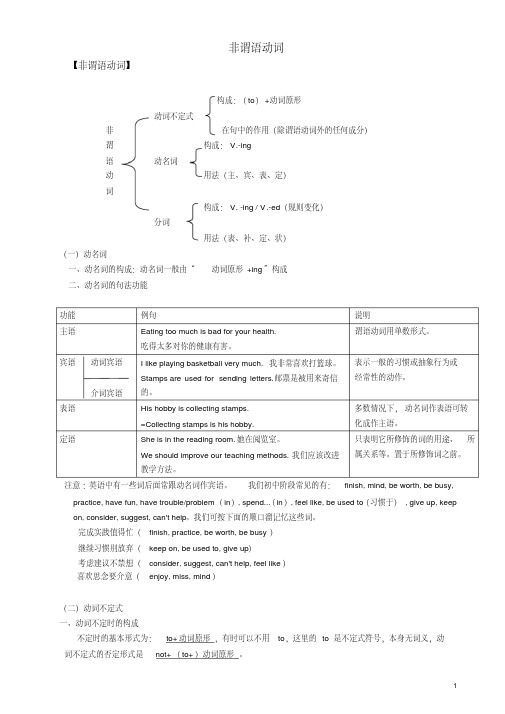
非谓语动词【非谓语动词】构成:(to)+动词原形动词不定式非在句中的作用(除谓语动词外的任何成分)谓构成:V.-ing语动名词动用法(主、宾、表、定)词构成:V. -ing / V.-ed(规则变化)分词用法(表、补、定、状)(一)动名词一、动名词的构成:动名词一般由“动词原形+ing”构成二、动名词的句法功能功能例句说明主语Eating too much is bad for your health.吃得太多对你的健康有害。
谓语动词用单数形式。
宾语动词宾语介词宾语I like playing basketball very much.我非常喜欢打篮球。
Stamps are used for sending letters.邮票是被用来寄信的。
表示一般的习惯或抽象行为或经常性的动作。
表语His hobby is collecting stamps.=Collecting stamps is his hobby. 多数情况下,动名词作表语可转化成作主语。
定语She is in the reading room.她在阅览室。
We should improve our teaching methods.我们应该改进教学方法。
只表明它所修饰的词的用途、所属关系等。
置于所修饰词之前。
注意:英语中有一些词后面常跟动名词作宾语。
我们初中阶段常见的有:finish, mind, be worth, be busy, practice, have fun, have trouble/problem(in), spend...(in), feel like, be used to(习惯于), give up, keep on, consider, suggest, can't help。
我们可按下面的顺口溜记忆这些词。
完成实践值得忙(finish, practice, be worth, be busy)继续习惯别放弃(keep on, be used to, give up)考虑建议不禁想(consider, suggest, can't help, feel like)喜欢思念要介意(enjoy, miss, mind)(二)动词不定式一、动词不定时的构成不定时的基本形式为:to+动词原形,有时可以不用to,这里的to 是不定式符号,本身无词义,动词不定式的否定形式是not+(to+)动词原形。
高中英语2025届高考语法复习非谓语动词知识讲解练习
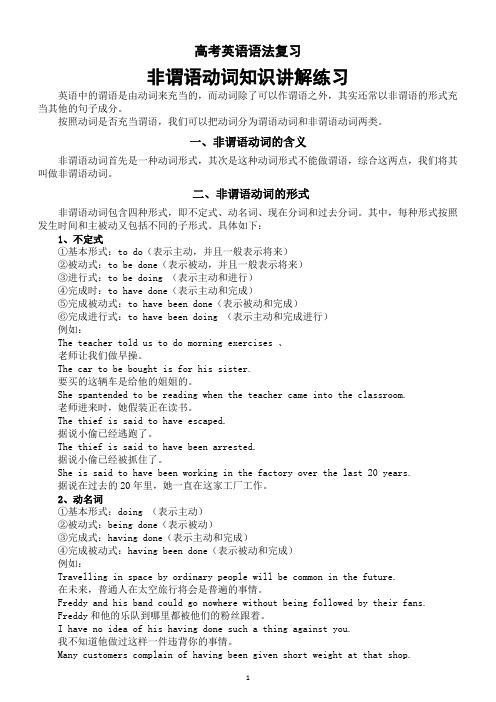
高考英语语法复习非谓语动词知识讲解练习英语中的谓语是由动词来充当的,而动词除了可以作谓语之外,其实还常以非谓语的形式充当其他的句子成分。
按照动词是否充当谓语,我们可以把动词分为谓语动词和非谓语动词两类。
一、非谓语动词的含义非谓语动词首先是一种动词形式,其次是这种动词形式不能做谓语,综合这两点,我们将其叫做非谓语动词。
二、非谓语动词的形式非谓语动词包含四种形式,即不定式、动名词、现在分词和过去分词。
其中,每种形式按照发生时间和主被动又包括不同的子形式。
具体如下:1、不定式①基本形式:to do(表示主动,并且一般表示将来)②被动式:to be done(表示被动,并且一般表示将来)③进行式:to be doing (表示主动和进行)④完成时:to have done(表示主动和完成)⑤完成被动式:to have been done(表示被动和完成)⑥完成进行式:to have been doing (表示主动和完成进行)例如:The teacher told us to do morning exercises 、老师让我们做早操。
The car to be bought is for his sister.要买的这辆车是给他的姐姐的。
She spantended to be reading when the teacher came into the classroom.老师进来时,她假装正在读书。
The thief is said to have escaped.据说小偷已经逃跑了。
The thief is said to have been arrested.据说小偷已经被抓住了。
She is said to have been working in the factory over the last 20 years.据说在过去的20年里,她一直在这家工厂工作。
2、动名词①基本形式:doing (表示主动)②被动式:being done(表示被动)③完成式:having done(表示主动和完成)④完成被动式:having been done(表示被动和完成)例如:Travelling in space by ordinary people will be common in the future.在未来,普通人在太空旅行将会是普遍的事情。
(完整版)非谓语动词——不定式讲解与练习

非谓语动词的类型:不定式(infinitive)、动名词(gerund)、分词(participle)一、Infinitive: 不定式(一)Structure 结构:to doNegative 否定:not to doPassive voice 被动:to be done(二)在句中作的成分:6个——主语、表语、宾语、宾语补足语、定语、状语1. 作主语Subject不定式作主语时,往往放在谓语之后,用it作形式主语。
It is adj. (for /of sb) to do sth.It is a pleasure/ an honor/ a pity to doIt takes/ took/ will take (sb) time to do2.表语PredicativeTo see is to believe. = Seeing is believing. 眼见为实。
3.宾语object下面动词只能用不定式作宾语,请牢记下列小诗:决心学会想希望,拒绝设法愿假装。
主动答应选计划,同意请求帮一帮。
decide / determine, learn, want, expect / hope / wish, refuse, manage, care, pretend, offer, promise, choose, plan, agree, ask / beg, help此外,afford, strive(斗争)等也要用不定式作宾语注意:think / consider/ find/ make/ feel + it (形式宾语) + adj. + to do 4.宾补Complementadvise, allow, ask, require, tell, order, want, persuade,beg, cause, encourage, expect, wish, forbid, permit, force, get, intend, invite, like, love, prefer, teach, warn, 等+ sb to do注意:当遇到下列动词时,不定式省略to:吾看三室两厅一感觉:五看(watch、see、look at、notice、observe), 三使(let、make、have),两听(listen to、hear),一感觉(feel)以上动词(除了let、make)还可用现在分词作宾语补足语,此外find, catch, keep, 也可以用现在分词作宾语补足语。
高考英语语法专题复习:非谓语动词讲义(不定式、动名词
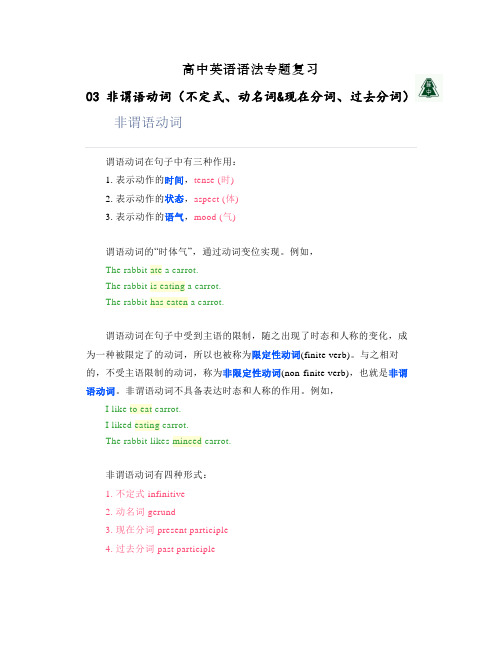
高中英语语法专题复习03 非谓语动词(不定式、动名词&现在分词、过去分词)非谓语动词谓语动词在句子中有三种作用:1. 表示动作的时间,tense (时)2. 表示动作的状态,aspect (体)3. 表示动作的语气,mood (气)谓语动词的“时体气”,通过动词变位实现。
例如,The rabbit ate a carrot.The rabbit is eating a carrot.The rabbit has eaten a carrot.谓语动词在句子中受到主语的限制,随之出现了时态和人称的变化,成为一种被限定了的动词,所以也被称为限定性动词(finite verb)。
与之相对的,不受主语限制的动词,称为非限定性动词(non-finite verb),也就是非谓语动词。
非谓语动词不具备表达时态和人称的作用。
例如,I like to eat carrot.I liked eating carrot.The rabbit likes minced carrot.非谓语动词有四种形式:1. 不定式 infinitive2. 动名词 gerund3. 现在分词 present participle4. 过去分词 past participle谓语动词是简单句的核心动词,非谓语动词只可能出现在其他的句子成分中。
1. 主语例:Swimming makes us hale and hearty.2. 宾语例:Janet suddenly stopped talking.3. 表语/主语补语例:Her wish is to become a doctor in the future.4. 宾语补语例:I invited him to come here.5. 定语例:Don't disturb the sleeping dog.6. 状语例:He went to the supermarket to buy a pen.不定式、动名词句子的核心动词只能由谓语动词充当,而非谓语动词可以充当句子的其他成分。
高考英语复习 非谓语动词(不定式)讲解

非谓语动词【不定式】非谓语动词【不定式】一不定式的作用二不定式的逻辑主语三不定式的时态和语态四省去to 的不定式三种非谓语动词形式,即不定式(to do)、动名词(doing)、分词(现在分词d oing &过去分词done)一不定式的作用1. 作主语(It + to do)不定式作句子主语的情况非常常见,通常有两种结构:(1)不定式t o do 直接放在句首的主语位置例:To l ove f or t he s ake o f b eing l oved i s h uman,but t o l ove f or t he s ake o f l oving i s a ngelic.因为被爱而爱,是人之常情;因为爱而爱,则难能可贵。
(2)不定式t o do 放在句末,而用i t 作形式主语指代句末的不定式这种情况下,又有不同结构,如①“It is +形容词+ to do”结构(此处的形式主语不能用t his 或t hat 来替换)Itis possible to give without loving,but it is impossible to love without giving.我们可以付出而不爱,但不可能爱而不付出。
②其他结构,如It takes time and efforts to master English.It is my duty to help you with English.2. 做宾语(动词+ to do)不定式作句子宾语,通常有三种可能的结构:(1)动词+ to do(句子主语和不定式逻辑主语一致)Ihope to see you again.(2)动词+疑问词+ t o d o在一些动词后,可以在连接代词(what ,which,who)或连接副词(how,when,where)及连词whether 后面接一个带t o 的不定式,可将该结构看成是连接词引导的宾语从句的简略形式。
高中英语非谓语动词全讲解:不定式

非谓语动词全讲解:不定式一、非谓语动词的概述非谓语有三大方面的内容是需要学习和掌握的,即:它们在句中所能充当的成分、时态和语态的变化以及逻辑主语。
二、非谓语动词有三种形式:1、不定式:可当作名词、形容词和副词来使用。
不定式在句中能够充当除谓语之外的其它任何成分。
2、动名词:动名词相当于名词,在句中充当主语、宾语、表语和定语。
3、分词:分词相当于形容词和副词,在句中主要充当定语、状语、补足语和表语。
非谓语动词作为动词的一种变化形式,仍保留有动词的特征。
比如:有自己的主语、时态和语态的变化。
因此学习非谓语动词有三个重要内容:充当句子成分,时态和语态的变化及逻辑主语。
三、不定式的具体讲解非谓语之不定式(to do):不定式作为一种动词的变化形式,具有动词的一般特征,即有时态和语态的变化。
不定式时态和语态的构成。
1、不定式的形式(动词+to do作宾语结构)此结构中不定式可直接与一个及物动词连用表示将来、目的或不定式的动作发生在谓语之后,动词常为表意愿、目地、企图等的词。
在句中若出现了不定式动作的执行者时,用不定式主动形式,若没有执行者或不定式所修饰的成份是不定式动作的承受者,用被动形式。
例:①I want someone to take some photos.②I want some photos to be taken.③She asked to be given an easy assignment.④The book is not allowed to be taken out of the library.⑤I come to see you⑥I hope to see you again2、不定式的形式(it is +adj+to do 作主语)①It is possible to give without loving,but it is not possible to love without giving.②It is important to master English well.3、特殊疑问词+to do (相当于一个名词短语)①I do not know whether to answer his letter.②I want to know what to do next.4、动词+it+宾语补足语+to do(不定式作宾语,不能直接放在动词后,要用it作形式宾语,不定式放在宾补后作真正的宾语)①I find it difficult to learn English well.②Allow sb to do sth \advise sb to do sth (动词+宾语+to do )四、不定式作定语修饰名词1、宾语关系:指被修饰的名词在逻辑意义上充当不定式的宾语。
高中语法专题解析非谓语动词

高中语法专题解析非谓语动词非谓语动词是指在句子中不充当谓语动词,具有名词、形容词和副词特征的动词形式。
在英语语法中,非谓语动词主要包括不定式、现在分词和过去分词。
本文将对非谓语动词的用法进行详细解析,并提供相关例句进行说明。
一、不定式不定式作为非谓语动词,一般形式为“to + 动词原形”,可以作为名词、形容词或副词使用。
1. 不定式作为名词用法不定式作为名词时,可以作为主语、表语、宾语、介词宾语或定语等。
例句:- To learn English well is my goal.(作主语)- His dream is to become a doctor.(作表语)- I want to buy a new car.(作宾语)- She is looking for a place to live in.(作介词宾语)- This is the book to study for the test.(作定语)2. 不定式作为形容词用法不定式作为形容词时,可以修饰名词或代词,并且位于被修饰词之后。
例句:- He has a lot of work to do.(修饰名词)- I have something important to tell you.(修饰代词)3. 不定式作为副词用法不定式作为副词时,可以修饰动词、形容词或副词,并且位于被修饰词之后。
例句:- He came home to rest.(修饰动词)- The movie is too long to watch.(修饰形容词)- She worked hard to pass the exam.(修饰副词)二、现在分词现在分词以-ing结尾,作为非谓语动词时,可以表示一个主动或进行的动作。
1. 现在分词作为形容词用法现在分词作为形容词时,可以修饰名词或代词,并且位于被修饰词之前。
例句:- The running water is clean.(修饰名词)- She saw a crying baby.(修饰代词)2. 现在分词作为副词用法现在分词作为副词时,可以修饰动词、形容词或副词,并且位于被修饰词之前。
高中语法非谓语动词之动词不定式讲解及练习(课堂PPT)

1
非谓语动词之动词不定式
• 动词不定式的语法功能 • 动词不定式的省略 • 动词不定式的否定式 • 动词不定式主动表示被动 • 动词不定式高考链接
2
动词不定式的简介
动词不定式是由to+动词原形组成,是动词的非 谓语形式。它可以带宾语,构成动词不定式短语, 在句中起名词、形容词和副词的作用,因此在句中 可以充当谓语以外的任何成分,即主语、表语、宾 语、定语、状语、宾补、主补和同位语。
8
2)be to 含有按计划,按命令做的事情或应该、可能、 注定发生的事情 例:We are to meet once a week. 我们按计划将一个月碰一次头。 What is to be done?应该怎么办? The key is nowhere to be found.可能
9
(4)动词不定式作宾语补足语或在被动语态中作主语补 足语 例:We'd love you to give us a hand.
11
(5)动词不定式短语作定语: When the question was was out,he was the first to raise his hand. I am afraid I can not attend your party, for I have too many things to do. ※注意: 1)当修饰的是不定代词如: everything,anything,much,little等,或被修饰的名 词前被形容词最高级,序数词,the only等强调 结构修饰时,非谓语动词作谓语只能用动词不定 式。 例:He was the last to realize the importance of this problem. Do you have anything to read? the first to arrive
高中英语2024届高考考点讲解与练习(非谓语动词作定语+非谓语动词作状语+非谓语动词作宾语补足语)

高考英语语法考点讲解与练习一、非谓语动词作定语【知识要点】1、非谓语动词包括四种:-to do不定式,-ing分词,-ed分词和动名词。
(重点为前三种)2、非谓语动词的词性及句法功能①-to do不定式相当于名词、形容词和副词,可以在句子中充当主语、宾语、表语、定语、状语和宾语补足语;②-ing分词相当于形容词和副词,可以在句子中充当表语、定语、状语和宾语补足语;③-ed分词相当于形容词和副词,可以在句子中充当表语、定语、状语和宾语补足语;④动名词相当于名词,可以在句子中充当主语、宾语、表语和定语。
3、前三种非谓语动词的形式与意义① -ing分词的基本意义为:主动或进行,变形有:进行式:doing被动式:being done完成式:having done完成被动式:having been done②-to do不定式的基本意义为:主动将来,变形有:进行式:to be doing被动式:to be done完成式:to have done完成被动式:to have been done③-ed分词表示被动或完成。
4、非谓语动词作定语由于三种非谓语动词都具有形容词的性质,所以它们都可以在句子中充当定语,并根据其在被修饰的名词中心词的前后位置,分为前置定语和后置定语两种。
the falling leaves (-ing分词作前置定语,“正在下落的叶子”)the leaves falling in the sky (-ing分词短语作后置定语,“正在空中下落的叶子”)the coming/following day (-ing分词作前置定语,“第二天”)the day to come (-to do分词短语作后置定语,“第二天”)the fallen leaves (-ed分词作前置定语,“已经落地的叶子/落叶”)the house burnt to the ground (-ed分词短语作后置定语,“被烧成废墟的房子”)【练习】单句语法填空1.Looking at the ______ (fall) leaves in the sky, he knows the fall is coming.2.Seeing the ______ (fall) leaves on the ground, he decided to do some sweeping first before sitting down to have a rest.3.It is said that the building ______ (build) here next year will be completed within one year.4.It is said that the building ______ (build) here now will be completed within one year.5.It is said that the building ______ (build) here last year will be rebuilt soon.6.The gentleman ______ (seat) next to Tom is his best friend.7.The gentleman ______ (sit) next to Tom is his best friend.8.The room was in a mass, with those ______ (break) furniture.9.The purely white snow looks like a beautiful blanket ______ (cover) the land.10.The police have got enough evidence ______ (prove) that he is guilty.11.Turn to the right and you will see a wide road ______ (lead) up to the building.12.If you get the first place, you will win an all expenses ______ (pay) journey.13.All the ______ (question) people supported the government’s latest policy.14.You should keep well the books ______ (borrow) from the library.15.Can those people ______ (seat) at the back hear me?二、非谓语动词作状语【知识要点】非谓语动词作状语由于三种非谓语动词都具有副词的性质,所以它们都可以在句子中充当状语。
非谓语动词--不定式(高中英语考点分析+精讲精练)

动词不定式考点一:不定式的时态和语态大多数情况下不定式以一般式形式出现,但在高考试题中往往会出现时态、语态的形式,如进行式、完成式、被动式等。
1.①----Is Bob still performing?----I'm afraid not.He is said________the stage already as he has become an officialA.to have leftB.to leaveC.to have been leftD.to be left②Police are now searching for a woman who is reported to____since the flood hit the area last Friday.A.have been missingB.have got lostC.be missingD.get lost③The crowd cheered wildly at the sight of Liu Xiang,who was reported______the world record in the110-meterhurdle race.A.breakingB.having brokenC.to have brokenD.break2.①The news reporters hurried to the airport,only____the film stars had left.A.to tellB.to be toldC.tellingD.told②He hurried to the station only____that the train had left.A.to have foundB.findingC.foundD.to find③He hurried to the booking office only________that all the tickets had been sold out.A.to tellB.to be toldC.tellingD.told3.①As the twentieth century came to a close,the raw materials for a great national literature were athand,waiting___________.A.to useB.to be usedC.to have usedD.to be using②It took a long time for the connection between body temperature and illness______.A.to make B.to be made C.making D.being made③The Chinese are proud of the29th Olympic Games______in Beijing in2010.A.holdB.holdingC.heldD.to be held④It remains________whether Jim’ll be fit enough to play in the finals.A.seenB.to be seenC.seeingD.to see⑤When asked why he went there,he said he was sent there for a space flight.A.trainingB.being trainedC.to have trainedD.to be trained⑥The children talked so loudly at dinner table that I had to struggle______.A.to be heardB.to have heardC.hearingD.being heard考点二:不定式的功能不定式是非谓语动词常见的一种形式,它具有名词的特征,在句子中可以作主语或宾语;具有形容词的特征,在句子中可以作表语、定语或补足语;具有副词的特征,在句子中可以作状语。
高中英语语法专题——非谓语动词讲解与练习 无答案
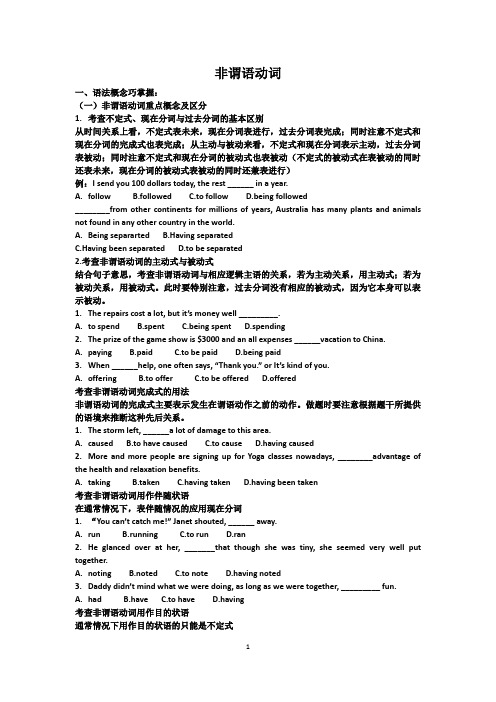
非谓语动词一、语法概念巧掌握:(一)非谓语动词重点概念及区分1.考查不定式、现在分词与过去分词的基本区别从时间关系上看,不定式表未来,现在分词表进行,过去分词表完成;同时注意不定式和现在分词的完成式也表完成;从主动与被动来看,不定式和现在分词表示主动,过去分词表被动;同时注意不定式和现在分词的被动式也表被动(不定式的被动式在表被动的同时还表未来,现在分词的被动式表被动的同时还兼表进行)例:I send you 100 dollars today, the rest ______ in a year.A.followB.followedC.to followD.being followed________from other continents for millions of years, Australia has many plants and animals not found in any other country in the world.A.Being separartedB.Having separatedC.Having been separatedD.to be separated2.考查非谓语动词的主动式与被动式结合句子意思,考查非谓语动词与相应逻辑主语的关系,若为主动关系,用主动式;若为被动关系,用被动式。
此时要特别注意,过去分词没有相应的被动式,因为它本身可以表示被动。
1.The repairs cost a lot, but it’s money well _________.A.to spendB.spentC.being spentD.spending2.The prize of the game show is $3000 and an all expenses ______vacation to China.A.payingB.paidC.to be paidD.being paid3.When ______help, one often says, “Thank you.” or It’s kind of you.A.offeringB.to offerC.to be offeredD.offered考查非谓语动词完成式的用法非谓语动词的完成式主要表示发生在谓语动作之前的动作。
(完整版)非谓语动词——不定式讲解与练习

(完整版)非谓语动词——不定式讲解与练习非谓语动词的类型:不定式(infinitive)、动名词(gerund)、分词(participle)一、Infinitive: 不定式(一)Structure 结构:to doNegative 否定:not to doPassive voice 被动:to be done(二)在句中作的成分:6个——主语、表语、宾语、宾语补足语、定语、状语1. 作主语Subject不定式作主语时,往往放在谓语之后,用it作形式主语。
It is adj. (for /of sb) to do sth.It is a pleasure/ an honor/ a pity to doIt takes/ took/ will take (sb) time to do2.表语PredicativeTo see is to believe. = Seeing is believing. 眼见为实。
3.宾语object下面动词只能用不定式作宾语,请牢记下列小诗:决心学会想希望,拒绝设法愿假装。
主动答应选计划,同意请求帮一帮。
decide / determine, learn, want, expect / hope / wish, refuse, manage, care, pretend, offer, promise, choose, plan, agree, ask / beg, help此外,afford, strive(斗争)等也要用不定式作宾语注意:think / consider/ find/ make/ feel + it (形式宾语) + adj. + to do 4.宾补Complementadvise, allow, ask, require, tell, order, want, persuade,beg,cause, encourage, expect, wish, forbid, permit, force, get, intend, invite, like, love, prefer, teach, warn, 等+ sb to do注意:当遇到下列动词时,不定式省略to:吾看三室两厅一感觉:五看(watch、see、look at、notice、observe), 三使(let、make、have),两听(listen to、hear),一感觉(feel)以上动词(除了let、make)还可用现在分词作宾语补足语,此外find, catch, keep, 也可以用现在分词作宾语补足语。
高中英语语法非谓语动词之动词不定式讲解及习题
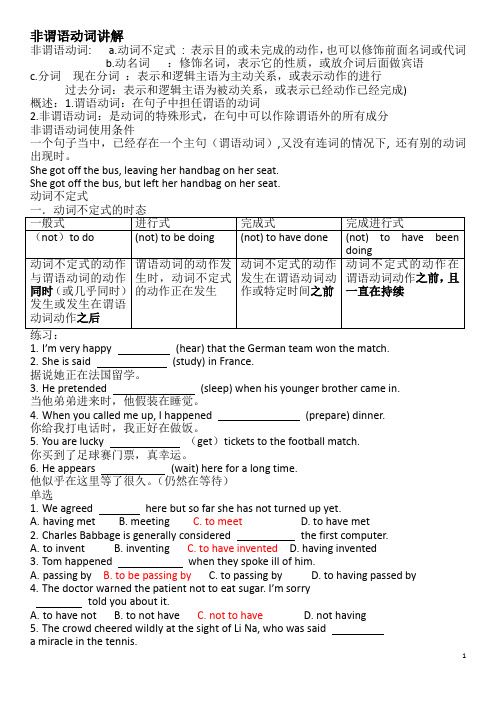
非谓语动词讲解非谓语动词: a.动词不定式: 表示目的或未完成的动作,也可以修饰前面名词或代词b.动名词:修饰名词,表示它的性质,或放介词后面做宾语c.分词现在分词:表示和逻辑主语为主动关系,或表示动作的进行过去分词:表示和逻辑主语为被动关系,或表示已经动作已经完成)概述:1.谓语动词:在句子中担任谓语的动词2.非谓语动词:是动词的特殊形式,在句中可以作除谓语外的所有成分非谓语动词使用条件一个句子当中,已经存在一个主句(谓语动词),又没有连词的情况下, 还有别的动词出现时。
She got off the bus, leaving her handbag on her seat.She got off the bus, but left her handbag on her seat.动词不定式一.动词不定式的时态一般式进行式完成式完成进行式(not)to do (not) to be doing (not) to have done (not) to have beendoing动词不定式的动作与谓语动词的动作同时(或几乎同时)发生或发生在谓语动词动作之后谓语动词的动作发生时,动词不定式的动作正在发生动词不定式的动作发生在谓语动词动作或特定时间之前动词不定式的动作在谓语动词动作之前,且一直在持续练习:1.I’m very happy (hear) that the German team won the match.2.She is said (study) in France.据说她正在法国留学。
3.He pretended (sleep) when his younger brother came in.当他弟弟进来时,他假装在睡觉。
4.When you called me up, I happened (prepare) dinner.你给我打电话时,我正好在做饭。
5.You are lucky (get)tickets to the football match.你买到了足球赛门票,真幸运。
高中语法非谓语动词之动词不定式讲解及练习共27页文档

10、一个人应该:活泼而守纪律,天 真而不 幼稚, 勇敢而 鲁莽, 倔强而 有原则 ,热情 而不冲 动,乐 观而不 盲目。 ——马 克思
66、节制使快乐增加并使享受加强。 ——德 谟克利 特 67、今天应做的事没有做,明天再早也 是耽误 了。——裴斯 泰洛齐 68、决定一个人的一生,以及整个命运 的,只 是一瞬 之间。 ——歌 德 69、懒人无法享受休息之乐。——拉布 克 70、浪费时间是一桩大罪过。——卢梭
高中语法非谓语动词之 动词不定式讲解及练习
6、纪律是自由的第一条件。——黑格 尔 7、纪律是集体的面貌,集体的声音, 集体的 动作, 集体的 表情, 集体的 信念。 ——马 卡连柯
8、我们现在必须完全保持党的纪律, 否则一 切都会 陷入污 泥中。 ——马 克思 9、学校没有纪律便如磨坊没有水。— —夸美 纽斯
超实用高考英语专题复习:08非谓语动词之动词不定式专项——赢战高考英语语法填空攻略(含历年高考真题)

赢战高考英语【语法填空】满分攻略距离高考还有一段时间,不少有经验的老师都会提醒考生,愈是临近高考,能否咬紧牙关、学会自我调节,态度是否主动积极,安排是否科学合理,能不能保持良好的心态、以饱满的情绪迎接挑战,其效果往往大不一样。
以下是本人从事10多年教学经验总结出的以下学习资料,希望可以帮助大家提高答题的正确率,希望对你有所帮助,有志者事竟成!养成良好的答题习惯,是决定高考英语成败的决定性因素之一。
做题前,要认真阅读题目要求、题干和选项,并对答案内容作出合理预测;答题时,切忌跟着感觉走,最好按照题目序号来做,不会的或存在疑问的,要做好标记,要善于发现,找到题目的题眼所在,规范答题,书写工整;答题完毕时,要认真检查,查漏补缺,纠正错误。
总之,在最后的复习阶段,学生们不要加大练习量。
在这个时候,学生要尽快找到适合自己的答题方式,最重要的是以平常心去面对考试。
英语最后的复习要树立信心,考试的时候遇到难题要想“别人也难”,遇到容易的则要想“细心审题”。
越到最后,考生越要回归基础,单词最好再梳理一遍,这样有利于提高阅读理解的效率。
另附靠前30天复习方法。
非谓语动词之动词不定式专项语法填空满分攻略提示词是动词作非谓语1.动名词作主语,宾语,表语,固定句式2.不定式作主语,宾语,表语,目的状语,固定句式3.分词现在分词表示主动、进行与逻辑主语是主动关系过去分词表示被动、完成与逻辑主语是被动关系作非谓语两个原则四个易错点原则1:理解句法功能,判断非谓语动词。
分析句中所缺少的成分,选择恰当的形式。
原则2:辨清逻辑关系,选择恰当的非谓语动词。
V+ing→主动、进行。
done→被动、完成。
易错点1.作状语时:V+ing 与主语逻辑上是主谓关系,做结果状语时表示顺其自然的结果。
done与主语逻辑上是动宾关系,做结果状语时,表示出乎意料的结果。
易错点2.做前置定语和表语时:V+ing表示“令人...的”done表示“感到...的”易错点3.做后置定语时:to do表示将要做;V+ing表示主动、进行;done表示被动、完成。
- 1、下载文档前请自行甄别文档内容的完整性,平台不提供额外的编辑、内容补充、找答案等附加服务。
- 2、"仅部分预览"的文档,不可在线预览部分如存在完整性等问题,可反馈申请退款(可完整预览的文档不适用该条件!)。
- 3、如文档侵犯您的权益,请联系客服反馈,我们会尽快为您处理(人工客服工作时间:9:00-18:30)。
非谓语动词——不定式非谓语动词分为三种形式:不定式,动名词和分词(分词包括现在分词和过去分词)。
不定式与动词原形同形,但它前面一般要带有一个不定式的符号“to”,也叫小品词,无词性,有时不定式也不带to。
“to” 是不定式符号还是介词,下列短语中的to 都是介词。
agree to object to close to , come to , lead to , refer to , equal to , familiar to ,point to , thank to , devote to , next to , belong to , be used to , look forward to1.不定式作主语当作不定式的主语较长时,常用it作形式主语而将真正的主语(不定式)放在谓语之后。
常见的带形式主语it的句型有:主要句型:It is easy (difficult, hard, important, possible, impossible, comfortable, necessary, better, right,wrong, foolish, wise, kind, cruel, nice, the first, the next, the last, the best, too much, too little, not enough) to do…..动词不定式逻辑主语是由for 作为标记的。
但是有时用of .区别:当使用for时,句中形容词修饰的是不定式,通常是一些表示可能性、难易程度、必要性等含义的形容词;而用of时,句中形容词修饰逻辑主语。
It’s necessary for you to study hard .(necessary 修饰to study hard,表示学习努力是有必要的)It’s foolish of him to do it .(foolish 修饰逻辑主语him)for与of的辨别可用以下方法:用介词后面的代词作主语,用介词前边的形容词作表语,造个句子。
如果道理上通顺用of,不通则用for。
如:You are nice.(通顺,所以应用of)He is hard.(人是困难的,不通,因此应用for)2.不定式作表语不定式可放在系动词如:be, remain, appear, get等后面后面,形成表语。
例如:My work is to clean the room every day. His dream is to be a doctor.Not to grasp firmly is not to grasp at all. What I want to do seems to tell you something. 比较:主语(事物)+ be +不定式(作表语)表示主语的具体内容主语(人)+ be +不定式(作表语)表示时态(将来时),为“即将”之意。
He is to clean the room. 他即将去打扫房间。
His plan is to clean the room. 他的计划是打扫房间。
3.不定式作宾语A. 动词+ 不定式afford, aim, appear, agree, arrange, ask, be, decide, bother, care, choose, come, dare, demand, desire, determine, expect, elect, endeavor, hope, fail, happen, help, hesitate, learn, long, mean, manage, offer, ought, plan, prepare, pretend, promise, refuse, seem, tend, wait, wish, undertakeB. 动词+ 疑问词+ to动词不定式作动词tell, show, understand, explain, teach, learn, advise, discuss等词的宾语时,前面常带疑问词。
即:疑问词(how, when, where, what, who)… + to do例如:He showed us how to do the work. Please tell us what to do next.C. 介词宾语动词不定式在介词but, except, besides后面时,如果介词之前有行为动词do的某种形式,那么这些介词后的不定式不带to,否则就要带to。
另外在can’t choose but和can’t help but 等后面的不定式也省略to。
例如:We could do nothing but wait. We had nothing to do but wait. We have no choice but to wait.4. 不定式作宾语补足语不定式作宾语补足语时省略to的情况:若不定式前的谓语动词是使役动词make,let,have(表示“让、使”)、感官动词see,watch,look at,observe,notice,hear,listen to,feel时,不定式符号to可以省略。
这些动词亦可总结为口诀:“五看三使两听一感觉”。
例如:Let's (to)go!走吧!He saw the thief (to)steal a lady’s cellphone.注:改为被动句时要把to还原,例如:The thief was seen to steal a lady’s cellphone.5.不定式作定语不定式有时修饰前边的名词或代词,在句子担当定语,通常要放在被修饰的词后。
例如:I have a lot of work to do . He is looking for a room to live in.(名词是to do的逻辑上宾语)作定语的不定式如果是不及物动词,或者不定式所修饰的名词或代词是不定式动作的地点、工具等,不定式后面须有相应的介词。
例如:There is nothing to worry about. Please give me a knife to cut with.当作定语的不定式所修饰的名词或代词是不定动作的承受者时,不定式既可以用主动语态,也可用被动语态,但其含义有所不同。
试比较:Have you anything to send? (不定式to send的动作执行者是“你”)Have you anything to be sent? (动作执行者是“我”或“别人”)6.不定式作状语目的状语He sat down to have a rest.(表目的)结果状语:表结果,表事先没有预料到的,不定式要放在句子后面。
不定时经常和only, never连用,强调结果和失望的情绪。
I hurried to get there only to find him out.After that day they were separated, never to see each other again.原因状语:1不定式可以在表示感情的形容词后面来修饰该形容词,表示原因。
常用于这种结构的形容词和过去分词有:happy, glad, delighted, pleased, sorry, eager,anxious, lucky, fortunate, proud, foolish等。
I’m glad to see you.2.修饰表示情感以外的形容词用于这类结构中,常用的形容词有:easy, difficult, hard,comfortable, pleasant。
在带有enough或too的句子里,也常用不定式作状语,表示程度。
例如:He was too excited not to say a few words. He is old enough to go to school.7.不定式在句中作为独立成分不定式在句中作为独立结构出现,用来说明说话人的态度。
可用固定词组和固定搭配来运用。
To tell you the truth, I have got no money about me. To be honest, I know nothing about it.1.Having finished her project, she was invited by the school to the new students.A.speaking B.having spoken C.to speak D.to have spoken 2.John has really got the job because he showed me the official letter him it.A.offered B.offering C.to offer D.to be offered3. We've had a good start, but next, more work needs ____ to achieve the final success.A. being doneB. doC. to be doneD. to be4. Before you quit your job, ______how your family would feel about your decision.A. considerB. consideringC. to considerD. considered5. We’re having a meeting in half an hour. The decision ______ at the meeting will in the future of our company.A. to be madeB. being madeC. madeD. having been made6.______to work overtime that evening, I missed a wonderful film.A. Having been askedB. To askC. Having askedD. To be asked7. This machine is very easy . Anybody can learn to use it in a few minutes.A. operatingB. to be operatingC. operatedD. to operate8. I looked up and noticed a snake ______ its way up the tree to catch its breakfast.A. to windB. windC. windingD. wound9. Before driving into the city, you are required to get your car ____.A. washedB. washC. washingD. to wash10.________ in a long queue, we waited for the store to open to buy a New iPad .A. StandingB. To standC. StoodD. Stand11 .If he takes on this work, he will have no choice but ______ an even greater challenge.A. meetsB. meetingC. meetD. to meet12. One learns a language by making mistakes and ______ them.A. correctsB. correctC.to correctD. correcting13. _______ with care, one tin will last for six weeks.A. UseB. UsingC. UsedD. To use14. The old man sat in front of the television every evening, happy ____ anything that happened to be on.A. to watchB. watchingC. watchedD. to have watched15. Tony lent me the money, ______that I’d do as much for him.A. hopingB. to hopeC. hopedD. having hoped16. Birds’ singing is sometimes a warning to other birds ________ away.A. to stayB. stayingC. stayedD. stay17 He got up late and hurried to his office, _________the breakfast untouched.A. leftB. to leaveC. leavingD. having left18. Film has a much shorter history, especially when_ such art forms as music andpainting.A. having compared toB. comparing toC. compare toD. comparedto19. The party will be held in the garden, weather .A. permittingB. to permitC. permittedD. permit20. After completing and signing it, please return the form to us in the envelope ________.A. providingB. providedC. having providedD. provide21. George returned after the war, only _______ that his wife had left him.A. to be toldB. tellingC. being toldD. told22. China recently tightened its waters controls near the Huangyan Island to prevent Chinesefishing boats from in the South China Sea.A. attackingB. having attackedC. being attackedD. having been attacked23. Pressed from his parents, and ______that he has wasted too much time , the boy is determined to stop playing video games.A. realizingB. realizedC. to realizeD. being realized24 "It's a such nice place," Mother said as she sat at the table________ for customs.A. to be reservedB. Living reservedC. reservingD. reserved25.I think Tom, as the head of a big department, should either study regularly or________ _his job.A. quitsB. to quitC. quittingD. quit26. No matter how bright a talker you are, there are times when it's better__________silent.A. remainB. be remainingC. having remainedD. to remain27.__________an important decision more on emotion than on reason, you will regret it sooner or later.A. BasedB. BasingC. BaseD. To base28. When for his views about his teaching job, Philip said he found it very interesting and rewarding.A. askingB. askedC. having askedD. to be asked29. I remembered the door before I left the office, but forgot to turn off the lights.A. lockingB. to lockC. having lockedD. to have locked1-5 C B C A A 6-10 A D C A A 11-15 D D C A A16-20 A C D A B 21-25 A C A D D 26-29 D B B B。
